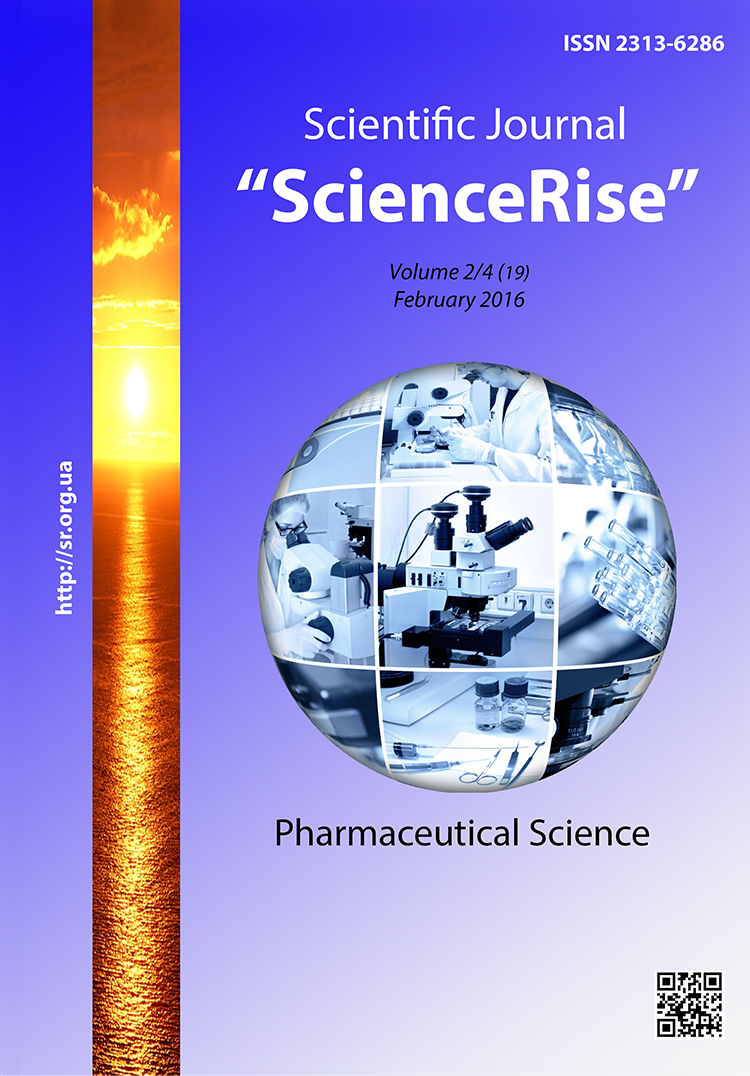Розробка методик визначення фенольних кислот та флавоноїдів у капсулах з сухим екстрактом Corylus avellana L.
DOI:
https://doi.org/10.15587/2313-8416.2016.61495Ключові слова:
капсули, Corylus avellana L., екстракт, ВЕТСХ, абсорбційна спектрофотометрія, фенольні кислоти, флавоноїдиАнотація
Питання стандартизації та контролю якості як рослин, так і лікарських засобів рослинного походження набуває актуальності, враховуючи той факт, що стандарти якості продукції є вкрай важливими, незалежно від того, чи вживає споживач лікарські рослини або лікарські засоби. Необхідність розробки методик стандартизації для вихідної рослинної сировини та капсульовано лікарської форми для подальшого контролю якості в умовах виробництва залишається актуальною.
Мета. Метою нашого дослідження була розробка простої, специфічної, точної та відтворюваної методики ідентифікації флавоноїдів та фенольних кислот у капсульованій лікарській формі з сухим екстрактом Corylus avellana L.
Методи. Для дослідження використовували зразки желатинових капсул з сухим екстрактом Corylus avellana L. для орального застосування. Аналіз проводили з використанням системи Camag для ВЕТСХ.
Визначення вмісту суми флавоноїдів методом абсорбційної спектроскопії здійснювали за допомогою спектрометра THERMO Scientific Evolution 60S у діапазоні хвиль 300–600 нм.
Результати. В результаті ВЕТСХ аналізу у капсульованій лікарській формі з сухим екстрактом Corylus avellana L. були ідентифіковані рутин та кверцитрин. Серед фенольних кислот були ідентифіковані неохлорогенова та хлорогенова кислоти.
В умовах проведення спектрофотометричного дослідження спектр випробовуваного розчину мав максимум поглинання за довжини хвилі 406 нм. Вміст суми флавоноїдів у желатинових капсулах з сухим екстрактом Corylus avellana L. у перерахунку на рутин становив 1,7 %.
Висновки. З метою визначення флавоноїдів та фенольних кислот у капсульованій лікарській формі з сухим екстрактом Corylus avellana L. були розроблені ефективні методики ВЕТСХ та абсорбційної спектрофотометрії.
Було визначено, що описані методики є достатньо перспективними для стандартизації капсул з сухим екстрактом Corylus avellana L. та можуть бути запропоновані для проведення контролю якості лікарської форми в умовах виробництва
Посилання
Bauer, R. (1998). Quality Criteria and Standardization of Phytopharmaceuticals: Can Acceptable Drug Standards be Achieved? Therapeutic Innovation & Regulatory Science, 32 (1), 101–110. doi: 10.1177/009286159803200114
Wani, M. (2007). Herbal medicine and its standardization. Pharmaceutical information, 1, 6.
Tsyvunin, V. V., Shtrygol’, S. Yu., Prokopenko, Yu. S., Toryanic, E. L. (2014). Experimental defining of anticonvulsant action of perspective phytogenic anticonvulsants. Ukrainian biopharmaceutical journal, 3 (32), 45–49.
Tsyvunin, V. V., Shtrygol’, S. Yu., Prokopenko, Yu. S., Geprgiyants, V. А. (2012). Screening research of the anticonvulsant action of dry extracts from 8 species of herbs members of the Solanaceae, Papaveraceae, Lamiaceae and Polemoniaceae families. Clinical pharmacy, 16 (4), 47–50.
Mishchenko, V. A. (2013). A targeted search of the anticonvulsant substances from herbs members of the Solanaceae family. Zaporizhzhya, 160.
Bluznyuk, N. A., Prokopenko, Yu. S., Geprgiyants, V. A. (2015). A comparative research of the flavonoids content in leaves of decorative shrubs – members of Ukrainian flora. Collection of scientific works of Shupyk NMA, 24 (4), 321–325.
Tistaert, C., Dejaegher, B., Heyden, Y. V. (2011). Chromatographic separation techniques and data handling methods for herbal fingerprints: A review. Analytica Chimica Acta, 690 (2), 148–161. doi: 10.1016/j.aca.2011.02.023
Attimarad, M., Mueen Ahmed, K. K., Aldhubaib, B. E., Harsha, S. (2011). High-performance thin layer chromatography: A powerful analytical technique in pharmaceutical drug discovery. Pharmaceutical Methods, 2 (2), 71–75. doi: 10.4103/2229-4708.84436
Sherma, J. (2010). Review of HPTLC in drug analysis: 1996–2009. Journal of AOAC International, 93 (3), 754–764.
Heyden, Y. V. (2008). Extracting information from chromatographic herbal fingerprints. LCGC Europe, 21 (9), 438–443.
Blatter, A., Reich, E. (2004). Qualitative and Quantitative HPTLC Methods for Quality Control of Stephania tetrandra . Journal of Liquid Chromatography & Related Technologies, 27 (13), 2087–2100. doi: 10.1081/jlc-120039420
Fang, C., Wan, X., Jiang, C., Cao, H. (2005). Comparison of HPTLC and HPLC for determination of isoflavonoids in several kudzu samples. Journal of Planar Chromatography – Modern TLC, 18 (101), 73–77. doi: 10.1556/jpc.18.2005.1.13
Spangenberg, B., Poole, C., Weins, C. (2011). Quantitative thin-layer chromatography: a practical survey. Berlin: Springer, 373. doi: 10.1007/978-3-642-10729-0
Selivanchikova, I. B., Lyakina, M. N., Kostennikova, Z. P. (2001). A quantitative determination of flavonoids in gomeopathic Thuja tinctures by the absorption spectroscopy method. Pharmacy, 6, 14–16.
##submission.downloads##
Опубліковано
Номер
Розділ
Ліцензія
Авторське право (c) 2016 Nataliya Blyznyuk, Yuliya Prokopenko, Victoriya Georgiyants

Ця робота ліцензується відповідно до Creative Commons Attribution 4.0 International License.
Наше видання використовує положення про авторські права Creative Commons CC BY для журналів відкритого доступу.
Автори, які публікуються у цьому журналі, погоджуються з наступними умовами:
1. Автори залишають за собою право на авторство своєї роботи та передають журналу право першої публікації цієї роботи на умовах ліцензії Creative Commons CC BY, котра дозволяє іншим особам вільно розповсюджувати опубліковану роботу з обов'язковим посиланням на авторів оригінальної роботи та першу публікацію роботи у цьому журналі.
2. Автори мають право укладати самостійні додаткові угоди щодо неексклюзивного розповсюдження роботи у тому вигляді, в якому вона була опублікована цим журналом (наприклад, розміщувати роботу в електронному сховищі установи або публікувати у складі монографії), за умови збереження посилання на першу публікацію роботи у цьому журналі.

